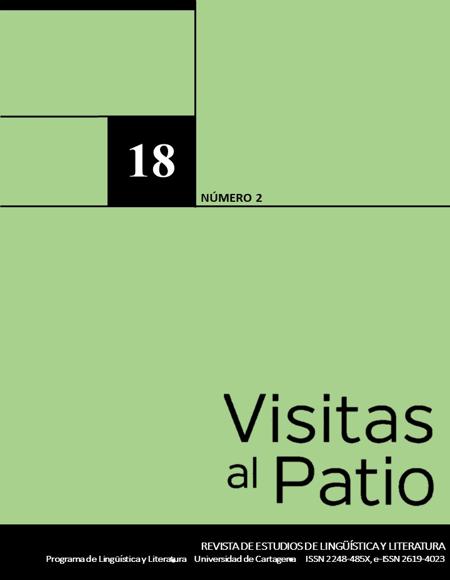Montaje estructural y manejo de secuencias. Aspectos de la visión dinámica de la Gramática Cognitiva de Ronald W. Langacker a la luz de la Teoría de Redes Relacionales de Sydney Lamb
Structural Assembly and Sequence Managing. Aspects of the Dynamic View of Ronald W. Langacker’s Cognitive Grammar in the Light of Sydney Lamb's Relational Network Theory
Contenido principal del artículo
Resumen
Palabras clave:
Descargas
Detalles del artículo
Referencias (VER)
Cuenca, M. J. y Hilferty, J. (1999). Introducción a la lingüística cognitiva. Barcelona: Editorial Ariel.
Dehaene, Stanislas. (2014). El cerebro lector. Buenos Aires: Siglo Veintiuno Editores.
Chafe, W. (1994). Discourse, Consciousness and Time. Chicago: The University of Chicago Press.
Gil, J. M. (2011). Una interpretación neurocognitiva de las redes sistémicas, en RASAL Lingüística, 1(2), 181-204.
Givón, T. (2005). Context as Other Minds. The Pragmatics of Sociality, Cognition and Communication. Amsterdam, Philadelphia: John Benjamins.
Gonzalo Cogno, et al. (2024). Minute-scale oscillatory sequences in medial entorhinal cortex. Nature, (625), 340-386.
Halliday, M. A. K. (2013). Meaning as choice. En Fontaine, L., Bartlett, T., O’Grady, G. (eds.). Systemic Functional Linguistics. Exploring Choice (pp. 15-37). Cambridge: The University of Chicago Press.
Ibarretxe-Antuñano, I. y Valenzuela Manzanares, J. (Coords.). (2012). Lingüística cognitiva. Madrid: Anthropos Editorial.
Lamb, S. (2006). Being realistic, being scientific, en LACUS Forum, (33), 201-209.
Lamb, S. (2009). Pathways of the Brain. The Neurocognitive Basis of Language. Amsterdam, Philadelphia: John Benjamins.
Lamb, S. (2011). Senderos del cerebro. La base neurocognitiva del lenguaje. Trad. J. M. Gil y A. M. García. Mar del Plata: EUDEM (Editorial de la Universidad Nacional de Mar del Plata).
Langacker, R. W. (1987). Foundations of cognitive grammar I. Stanford: Stanford University Press.
Langacker, R. W. (1991a). Concept, Image, and Symbol. The Cognitive Basis of Grammar. Berlin, New York: Mouton de Gruyter.
Langacker, R. W. (1991b). Foundations of cognitive grammar II. Stanford: Stanford University Press.
Langacker, R. W. (2000). Grammar and Conceptualization. Berlin: Walter de Gruyter.
Langacker, R. W. (2008). Cognitive Grammar: A Basis Introduction. New York: Oxford University Press.
Langacker, R. W. (2014). Subordination in a dynamic account of grammar. En Visapää, L., Kalliokoski, J., Sorva, H. (Edit.). Contexts of Subordination (pp. 17-72). Amsterdam, Philadelphia: John Benjamins.
Langacker, R. W. (2016). Baseline and Elaboration. Cognitive Linguistics, 27(3), 405-439.
Lee, N. et al (2009). The Interactional Instinct. The evolution and acquisition of language. Oxford, New York: Oxford University Press.
Müller, G. E. (2012). Evaluación epistémica, evidencialidad y puesta en escena de los participantes en el coloquio de la defensa de tesis. En Müller, G. E., Miñones, L. y Barbeito, V. (comps.). Estudios de Lingüística Cognitiva (pp. 271-282). Mendoza: EDIUNC (Editorial de la Universidad Nacional de Cuyo.
Müller, G. E. (2020). La relación paradojal entre Macroestructura y Periferia: Paréntesis discursivos como estrategias macroestructurales en la configuración dinámica del argumento. En Schrott, A. y Tesch, B. (ed.). Competencia textual y complejidad textual. Perspectivas transversales entre didáctica y lingüística (pp. 147-165). Berlin: Peter Lang.
Müller, G. E. (2023). Parentéticas: Elaboración construccional y cuestiones limítrofes, en Cuadernos de la ALFAL “De la oración al discurso”, 15(2), noviembre 2023, 140-168.
Paz, O. (1990). Ortega y Gasset: el cómo y el para qué. En Paz, O. Hombres en su siglo y otros ensayos (pp. 97-110). Barcelona: Seix Barral.
Talmy, L. (2003). Toward a Cognitive Semantics. Volume I: Concept structuring systems. Cambridge, Massachusetts y London, England: The MIT Press.



 PDF
PDF
 FLIP
FLIP
 HTML
HTML




